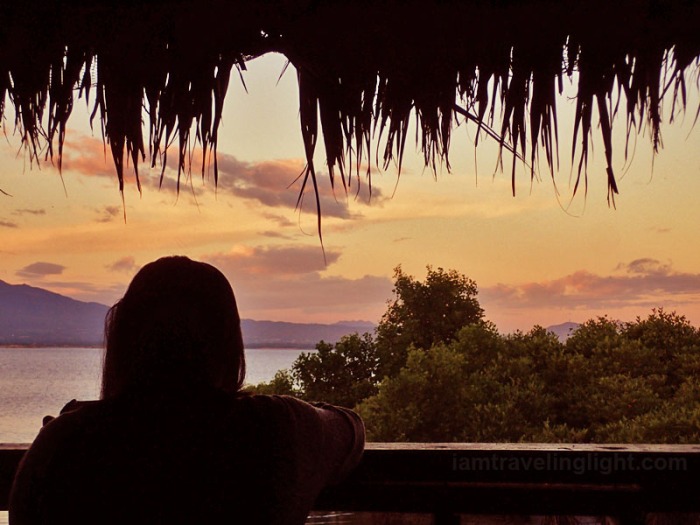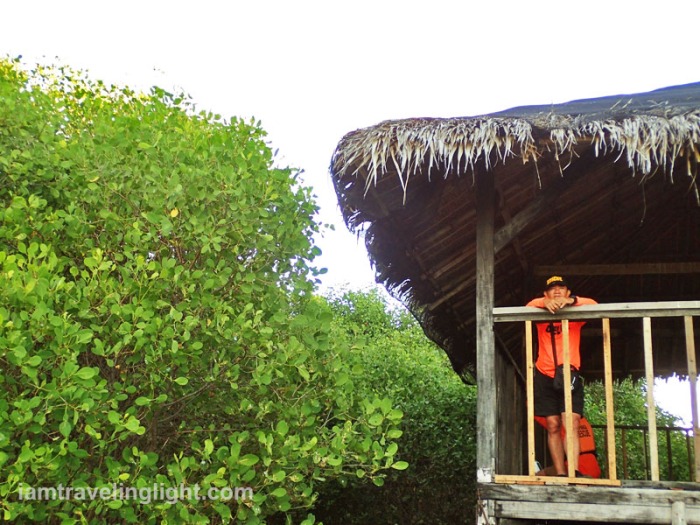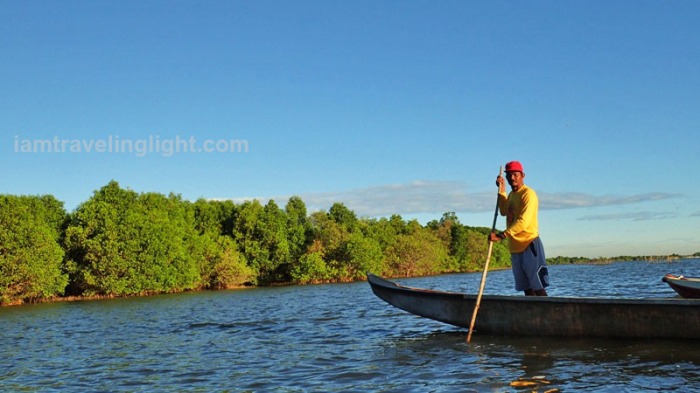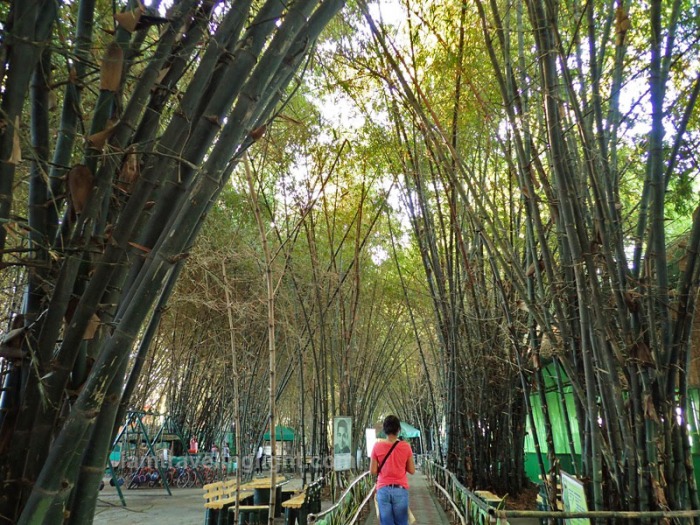(UPDATED February 2019) It was still dark when our group boarded an outrigger boat on the river off the bamboo park in Lubao, Pampanga. Some stars still shone in the predawn sky. As our boat cut through the waters, the sky began to lighten with oranges and blues. But soon, dark spot upon dark spot flew across the brightening sky.

Early boat ride. This is the best time to set off to see the birds.

Just among the many birds we saw during our boat ride
These were birds passing through their migration routes. This path we were taking, and the mangrove forest we were heading to, is part of the East Asian-Australasian Flyway, a “highway” for migratory birds which come from as far as Russia or Siberia.
After around 40 minutes we arrived at rows of mangroves seemingly floating on the river, with only a wooden walkway for access. This was our destination, the Sasmuan Bangkung Malapad Critical Habitat Ecotourism Area (SBMCHEA), more known as Bangkung Malapad. We had traveled by boat from one municipality, Lubao, to the next, Sasmuan.
We stepped on the walkway, with mangroves thick on either side. We were indeed walking into a forest, and the 300-meter bridge only gives glimpses of it. The forest was quiet, save for our footsteps and occasional birdcall.

We crossed this 300-meter bamboo bridge to get to the mangrove forest.
Some of the mangroves in SBMCHEA were planted by locals, I would find out later, but the rest grew in the wild, and how they grew and how the soil they grew on came to be makes for an interesting story. It was Mt. Pinatubo’s eruption in 1991 that gave birth to the islet that was to become Bangkung Malapad. The volcano spewed sediments that eventually became a landmass in Pasak River. Migrating birds stopped to rest and feed here, some instrumental in carrying mangrove seeds, according to Sasmuan Tourism Officer Jason Salenga. Eventually, Bangkung Malapad indeed widened, as its name suggests, now spanning 894 hectares of mangrove forests and mudflats, and home or resting spot to over 26,000 birds.
As we reached the end of the walkway, we found an open-air hut with a full view of the mangrove-fringed bay, with Bataan’s mountains in the distance. Occasionally, whiskered terns, barn swallows, and other birds sailed above the greenery.

The hut at the end of the wooden walkway

Taking in the mangroves and the morning sky from the hut

It feels peaceful being surrounded by mangroves.
As the tide was still low, some of us went down to the mudflats to get closer to the mangroves.

Mangroves and saltwater

Bataan’s mountains in the horizon
The mangroves slowly took on a golden-green glow as the sun rose higher. Different birds passed by, some flying low, others flying high, above the mangroves. It was a perfect, quiet morning.

I looked at the mangroves – and occasionally, up the sky, when birds flew by.
Bantay Dagats, the local sea patrol walked around the mangroves, keeping a watchful eye in the area. They had also accompanied our group to the islet, riding on a boat not far from our group. They are among the locals who help protect and preserve Bangkung Malapad.

Just one of the locals protecting Bangkung Malapad
While the story of how Bangkung Malapad came to be is interesting, the story on how this critical habitat protects and is protected is inspiring. Because of Bangkung Malapad’s mangroves acting as a buffer against wind and waves, some of Pampanga’s barangays were spared from Typhoon Glenda in 2014. Those who had fish ponds instead of mangroves on their waters were not as lucky. Thus, the locals had a stronger, renewed commitment to protect their mangroves. The local patrol ensured no mangroves were cut. The community participated in planting mangroves.
The local government also worked with private companies who helped with the critical habitat’s conservation. One telecommunications company installed sensors that digitally measure water level and record other data that would help in assessing threats and other concerns.
The place is also giving back to locals in another way – through ecotourism, as the local government is eyeing more birdwatchers and tourists to visit the place.

Sasmuan’s tourism officer pointing out some kinds of mangroves
SBMCHEA is not just a beautiful place of birds and forests but is also a story of how the local community work together in protecting part of their home and are also enriched by it.
Later, I found out another interesting trivia from Sasmuan’s tourism officer: that SBMCHEA is along Manila Bay’s waterway and also helps curb its pollution.

These are the same waters that flow through Manila Bay, and help control its pollution.

The sun has fully risen when we made our way back to the entrance

The wooden bridge looks brighter now under the risen sun.
On our way back to the mainland, we saw more birds – specks of white sailing across the bright blue sky, some diving down close to the water to look for food. The rows and rows of mangroves looked a brighter, crisper green under the already risen sun.

We saw birds again on our way back, this time under full sunlight.

An egret looking for food in the water
As we stepped again on mainland, towering bamboo groves greeted us. This was the Lubao Bamboo Hub and Eco-Park, now visible under the morning sun. Our group had a hearty breakfast and sat under the bamboos. It was a relaxing ending to a quiet morning of forest walks and bird watching.

We went back to Lubao’s bamboo park at the end of our tour.

Relaxing under the bamboos is a great way to cap the tour.
How to get there
From Manila, ride a bus bound for Olongapo or Balanga. Genesis, Victory Liner, or Bataan Transit buses usually ply this route from Edsa Cubao. Get off at Sta. Rita. From here, ride a jeep to Guagua. From Guagua town proper, ride a tricycle to the jumpoff to Bangkung Malapad in Sasmuan. Total travel time is around two and a half hours or more. You need to book your tour ahead with the Sasmuan Bangkung Mapalad Critical Habitat and Ecotourism Area (SBMCHEA) official Facebook page
If you are flying to Manila, you can easily get cheap flight tickets from budget airlines like AirAsia and Cebu Pacific.
Sample budget breakdown
Transportation (bus and tricycles) Allot a budget of P500 to be sure
Boat around Bangkung Malapad P250 per person (One boat is P2500)
Environmental fees P120
Lunch prepared by the locals Starts at P175
TOTAL P1,045




ganda ms claire. meron ka ba sa ilocos tour blog ?